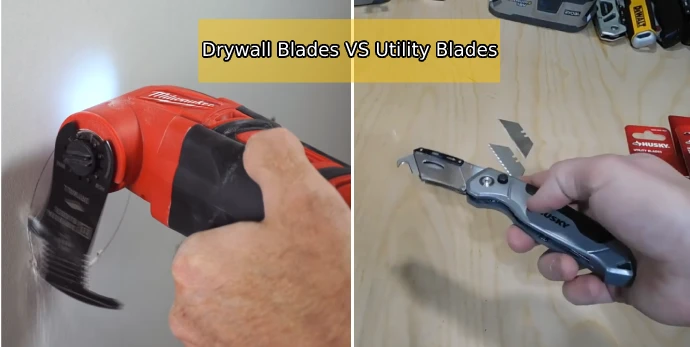Last Updated on July 31, 2023
Drywall and utility blades are commonly used tools in a variety of different projects. Regardless of the size or scope of your project, having the right blade for the job can make all the difference.
Drywall blades are designed particularly for cutting drywall, while utility blades are more general purpose and can be used for tasks such as cutting plastic, carpeting, and much more.
Here we will compare and contrast the features, benefits, and overall efficiency of drywall blades and utility blades to help you decide which one is best suited for your next project.
We’ll be looking at factors like strength and durability, cutting power and accuracy, versatility, price and cost analysis, and many more. By the end, you should have all the information you need to make an informed decision about which tool is right for your project. So let’s get started.
Drywall Blades Vs Utility Blades: Comparison & Contrast
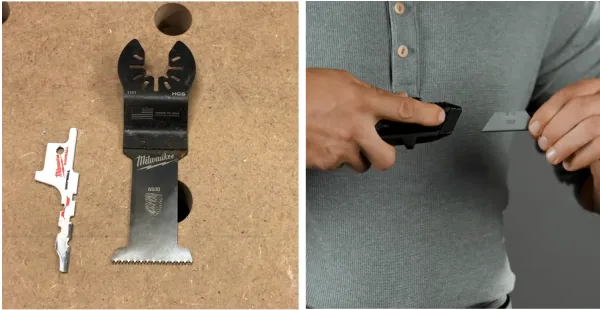
Strength & Durability
Drywall blades are designed for cutting drywall, plasterboard, and other materials that require precision and strength.
These types of blades are made from high-carbon steel. They have a very sharp edge that will stay sharp for a long time. This makes them durable and strong enough to cut through different types of materials like fiberglass insulation, vinyl siding, and hardwood flooring.
Drywall blades also feature a long-lasting finish that can resist corrosion from moisture and dust, making them ideal for use in damp or dusty environments.
In comparison to utility blades, drywall blades provide better strength and durability due to their specialized construction and hardened steel blade material.
Cutting Power & Accuracy
Drywall blades are designed with greater cutting power than utility blades, which allows them to quickly and accurately slice through drywall material with greater ease.
The specialized shape of the blade also helps to reduce friction, making it easier to make precise cuts without compromising accuracy or quality.

They are designed to cut deeper into the material than most other types of blades, allowing for added control and accuracy when making precise shapes and designs.
Versatility
A drywall saw blade is good to use because it can cut different materials, not just drywall. It can also cut ceramic tiles, cement boards, and thin plywood. It can even cut soft materials like balsa wood or foam core board.
These versatile tools usually come with different sizes and tooth configurations which can be used for making straight or curved cuts depending on the project requirements.
Price & Cost Analysis
Drywall blades tend to cost more than standard utility knives due to the higher quality materials used in their construction and the special design features they include.
These increased costs are offset by the fact that drywall blades require less frequent replacement over time since they are not prone to wear and tear as traditional utility knives would be due to their sturdier construction.
Many models come with multiple additional features, such as built-in dust guards, which further lower long-term costs associated with maintenance by helping protect against debris buildup in one’s work area or workspace environment.
Safety Concerns & Risks Involved
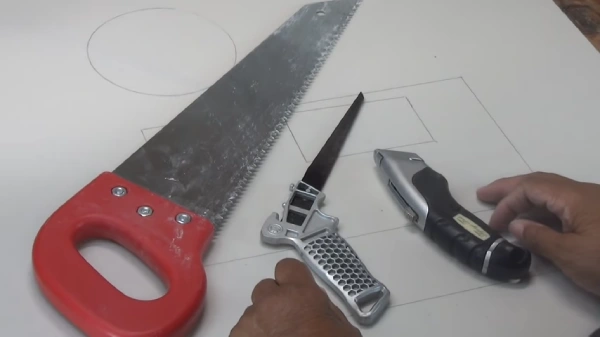
When comparing the safety and risk associated with drywall blades and utility blades, note that there are inherent safety risks with both. Drywall blades are designed with a sharper edge than a typical utility knife blade. This allows for a more precise cut when cutting thin materials such as drywall or plasterboard.
If you do not use this knife correctly, it could cut you very deeply or even puncture your skin. To reduce the risk of accidents, it is always recommended to use the blade in a controlled manner, keeping your fingers away from the blade’s path.
When you need to take the blade out of the handle, hold onto the handle tightly and pull it away from your body at an angle. This will help you avoid accidentally cutting yourself.
Utility blades are designed with wider and thicker edges which makes them more difficult to control accurately while cutting.
This can make it easier for users to slip up while using them and potentially cause injury if care is not taken to remain vigilant around their use.
There are some risks when using a knife, but you can reduce them by holding the handle firmly and always retracting the blade after use. Some knives have an auto-retract feature that helps prevent accidental cuts.
Maintenance Requirements
Drywall blades don’t need to be sharpened as often as utility blades. This is because they are designed for more delicate projects that require precision, like cutting drywall or plasterboard.
Drywall blades only need to be sharpened every once in a while. But the handle usually comes with new blades that can be used when the old ones get too worn down from being used. It is important to replace the blades regularly so that you can keep making accurate cuts.
Utility knives have a wide, thick blade that gets blunt after being used for a long time. This makes them less effective at cutting. You need to sharpen the blade regularly to keep it sharp. You also need to clean the knife regularly, or else the blade will get dull quickly from all the built-up residue.
Practicality
When comparing the practicality of drywall blades versus utility blades, it is important to consider the different applications that each type of blade is best suited for.
Drywall blades are designed to cut through wallboard with minimal effort. They are ideal for large projects because they can make multiple cuts quickly without needing to be sharpened or replaced as often as utility blades.
Drywall blades are thicker and stronger than most utility knives. This makes them less likely to break when you do a lot of work, such as removing walls or renovating. When doing these types of projects, be accurate so that the results look professional.
Utility knives are better for lighter projects, such as opening boxes or cutting thin pieces of paper. Their thinner design allows them to be more precise in intricate tasks.
Environmental Impact
The environmental impacts between these two types of cutting tools vary greatly based on what type of material they interact with during operation. Drywall knives have a small environmental impact.
They are mostly used on lightweight materials, like paper-like gypsum board. Most manufacturers use sustainable manufacturing techniques to make sure that there is very little waste created during production.
On the other hand, traditional utility knives may interact with materials like plastic packaging, which not only involves waste but also creates large amounts of carbon emissions depending on the source used.
Therefore, when considering the environmental impacts of these two types of tools, dry walling provides a far better eco-friendly option due to its lighter-weight materials usage.
Convenience
Compared to the features of utility blades with drywall blades, drywall blades are designed to make slicing drywall easier and more efficient. Drywall blades are typically wider and longer than utility blades, which makes it easier to cut through multiple layers of drywall at once.
They also feature longer teeth with sharper points, which help reduce the amount of force needed to cut through the material.
Drywall blades also typically have a serrated edge for added convenience when cutting multiple layers at once. Some manufacturers offer special ergonomic handles that make it easier and more comfortable for users to hold and maneuver the blade for precise cuts.
Availability
Both drywall blades and utility blades can be found in most hardware or home improvement stores as well as online retailers.
When shopping online, it’s important to read reviews from other customers to ensure you’re finding quality products with good reviews.

There are many different sizes available when it comes to both types of blades, so shoppers have plenty of options when making their selections.
Overall Efficiency
When comparing the features of drywall blades with utility blades, overall efficiency is certainly an important factor to consider.
Drywall blades are designed specifically to make cutting drywall faster and easier, so they tend to be more efficient than traditional utility knives in most cases.
They also tend to last longer due to their sturdier construction and sharp points that slice through the material quickly and accurately without excessive force or crushing damage on the blade itself.
Can I use a Utility Knife for Drywall?
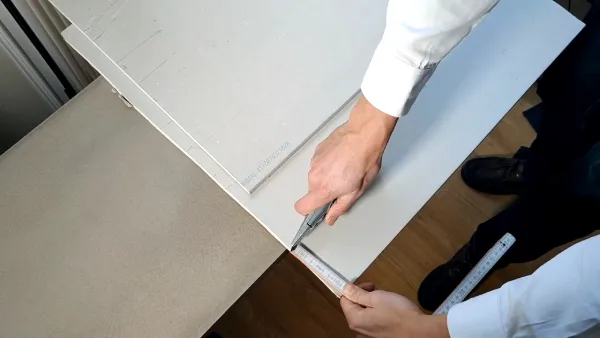
Yes, you can utilize a utility knife for drywall. Note that this type of knife does not usually have the power or precision necessary for drywall cutting and can easily cause damage if used incorrectly.
To cut drywall effectively, it is strongly recommended to use a special blade designed specifically for drywall.
These blades are typically made from a higher grade of steel than standard utility blades and feature an offset angle designed to cut through the gypsum board without causing unnecessary damage.
These blades often come in different shapes and sizes so that you can choose the one that best suits your needs.
Do You Need a Special Blade to Cut the Drywall?
You do need a unique blade to cut drywall effectively. Standard utility knife blades may not be suitable for cutting drywall due to their thickness and difficulty in getting into tight spaces.
To make precise cuts on the wallboard, you should use a special type of blade known as a snap-off blade. Snap-off blades are planned specifically for cutting soft materials such as wallboard.
They have a thin profile that allows them to get into tight spaces easily while still being able to make precise cuts without chipping or gouging the material.
Snap-off blades are designed with multiple sharp points along their length so that users can easily snap off sections of the dulled blades without having to change out the entire tool constantly.
What Tool is Most Used When Cutting Drywall?
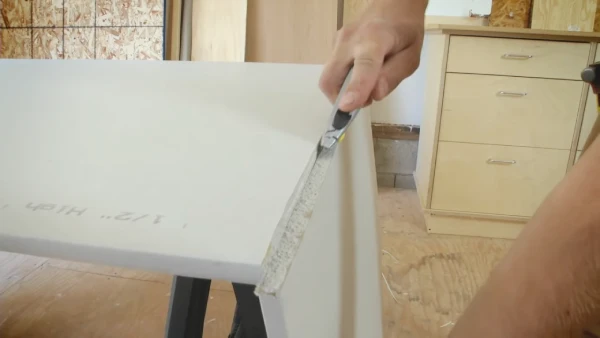
The most used tool when cutting drywall is an oscillating multi-tool fitted with a drywall saw attachment. Oscillating multi-tools have become popular over recent years because they can perform many different types of jobs quickly and efficiently.
When equipped with a drywall saw accessory, they can make precise cuts along walls and ceilings perfectly suited for professional applications like installing trim or hanging artwork.
Unlike standard utility knives, these tools will not chip or gouge the surface of the wallboard due to their thinner profile and ability to adjust speed settings based on the material being cut.
Some models come with built-in dust extraction systems, which help keep work areas cleaner during renovations or other projects in confined spaces where dust control is important.
What are Utility Blades Used for?
Utility knives are primarily used for slicing materials such as paper, cardboard, and plastic wrap but can also be used for other tasks such as scoring plasterboard or removing tiles from plasterboard walls, or excess grout from between tiles.
Utility knives are also commonly used by carpenters for making intricate markings on woodworking projects or creating decorative finishes such as chamfering edges or adding etchings into raw wood surfaces.
It should be noted that when using utility knives in these applications, it is important to ensure that they are kept sharp at all times in order to produce accurate results safely and efficiently every time they’re used.
Final Thoughts
When choosing between a drywall blade and a utility blade, it is important to consider all the factors that have been discussed in this article. Which type is best suited depends on your project goals as well as the budget that you have available.
Both types offer advantages such as their strength & durability, cutting power & accuracy, but they also come with potential risks that should be considered before making any decision.
In addition to all the other factors like maintenance requirements & practicality, it is also essential to keep in mind their environmental impact as well as availability when selecting which tool is suitable for your next project.
By taking into account all these factors, you can ensure that you select the most suitable type of tool equipped with good-quality material so that you achieve maximum results without any unexpected complications or costs associated with it.
